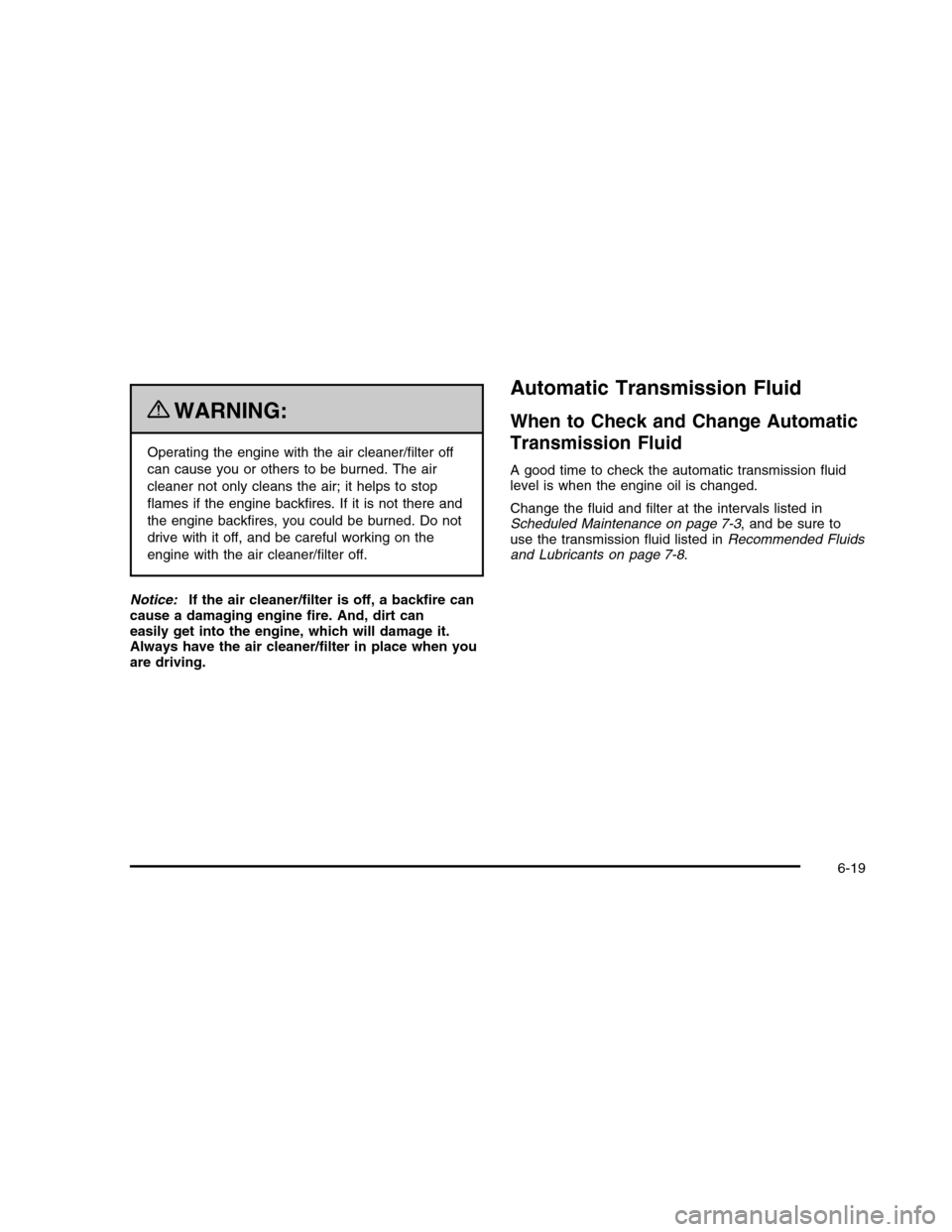CADILLAC DTS 2010 1.G Owners Manual
Manufacturer: CADILLAC, Model Year: 2010, Model line: DTS, Model: CADILLAC DTS 2010 1.GPages: 480, PDF Size: 17.56 MB
Page 331 of 480

Hood Release
To lift the hood:
1. Pull the hood releaselever with this symbolon it. It is locatedon the lower left side ofthe instrument panel.
2. Then go to the front of the vehicle and find thesecondary hood release lever, located near thecenter of the hood. Move the release lever up andto the right to raise the hood.
Before closing the hood, be sure all filler caps are onproperly. Then pull the hood down and close it firmly.
6-11
Page 332 of 480

Engine Compartment Overview
When you open the hood, here is what you will see:
4.6L L37 Engine shown, 4.6L LD8 Engine similar
6-12
Page 333 of 480

A.Underhood Fuse Block on page 6-101.
B. Remote Positive (+) Terminal. SeeJump Starting onpage 6-36.
C. Windshield Washer Fluid Reservoir. See “AddingWasher Fluid” underWindshield Washer Fluidon page 6-31.
D. Engine Coolant Surge Tank and Pressure Cap.SeeEngine Coolant on page 6-23.
E. Remote Negative (!) Terminal. SeeJump Startingon page 6-36.
F.Power Steering Fluid on page 6-30.
G. Engine Oil Fill Cap. See “When to Add Engine Oil”underEngine Oil on page 6-13.
H. Engine Oil Dipstick. See “Checking Engine Oil”underEngine Oil on page 6-13.
I. Brake Master Cylinder Reservoir. See “Brake Fluid”underBrakes on page 6-32.
J. Automatic Transmission Fluid Cap and Dipstick(Out of View). SeeAutomatic Transmission Fluid onpage 6-19.
K.Engine Air Cleaner/Filter on page 6-17.
Engine Oil
Checking Engine Oil
It is a good idea to check the engine oil level at eachfuel fill. In order to get an accurate reading, the oil mustbe warm and the vehicle must be on level ground.
The engine oil dipstick handle is a yellow loop. SeeEngine Compartment Overview on page 6-12forthe location of the engine oil dipstick.
1. Turn off the engine and give the oil several minutesto drain back into the oil pan. If this is not done, theoil dipstick might not show the actual level.
2. Pull out the dipstick and clean it with a paper towelor cloth, then push it back in all the way. Remove itagain, keeping the tip down, and check the level.
6-13
Page 334 of 480

When to Add Engine Oil
If the oil is below the cross-hatched area at the tip ofthe dipstick, add at least one quart/liter of therecommended oil. This section explains what kind of oilto use. For engine oil crankcase capacity, seeCapacities and Specifications on page 6-109.
Notice:Do not add too much oil. If the engine hasso much oil that the oil level gets above thecross-hatched area that shows the proper operatingrange, the engine could be damaged.
SeeEngine CompartmentOverview on page 6-12forthe location of theengine oil fill cap.
Add enough oil to put the level somewhere in the properoperating range in the cross-hatched area. Push thedipstick all the way back in when through.
6-14
Page 335 of 480

What Kind of Engine Oil to Use
Look for three things:
•GM4718M
This vehicle’s engine requires a special oil meetingGM Standard GM4718M. Oils meeting thisstandard may be identified as synthetic. However,not all synthetic oils will meet this GM standard.Use only an oil that meets GM Standard GM4718M.
Notice:Using oils that do not have the GM4718MStandard designation can cause engine damage notcovered by the vehicle warranty.
•SAE 5W-30
SAE 5W-30 is best for the vehicle. These numberson an oil container show its viscosity, or thickness.Do not use other viscosity oils such as SAE 20W-50.
•American Petroleum Institute (API) starburst symbol
Oils meeting theserequirements should havethe starburst symbol onthe container. This symbolindicates that the oilhas been certified by theAmerican PetroleumInstitute (API).
This vehicle’s engine was filled at the factory with aMobil 1®synthetic oil meeting all requirements forthis vehicle.
Substitute Engine Oil: When adding oil to maintainengine oil level, oil meeting GM Standard GM4718Mmight not be available. You can add substitute oildesignated SAE 5W-30 with the starburst symbol at alltemperatures. Substitute oil not meeting GM StandardGM4718M should not be used for an oil change.
6-15
Page 336 of 480

Engine Oil Additives / Engine Oil
Flushes
Do not add anything to the oil. The recommended oilswith the starburst symbol that meet GM standards are allthat is needed for good performance and engineprotection.
Engine oil system flushes are not recommended andcould cause engine damage not covered by the vehiclewarranty.
Engine Oil Life System
When to Change Engine Oil
This vehicle has a computer system that indicates whento change the engine oil and filter. This is based onengine revolutions and engine temperature, and not onmileage. Based on driving conditions, the mileage atwhich an oil change is indicated can vary considerably.For the oil life system to work properly, the systemmust be reset every time the oil is changed.
When the system has calculated that oil life has beendiminished, it indicates that an oil change is necessary.A CHANGE ENGINE OIL SOON message in theDriver Information Center (DIC) comes on. Change theoil as soon as possible within the next 600 miles(1 000 km). It is possible that, if driving under the bestconditions, the oil life system might not indicate thatan oil change is necessary for over a year. However, theengine oil and filter must be changed at least once ayear and at this time the system must be reset.Your dealer/retailer has trained people who will performthis work using genuine parts and reset the system.It is also important to check the oil regularly and keep itat the proper level.
If the system is ever reset accidentally, the oil must bechanged at 3,000 miles (5 000 km) since the last oilchange. Remember to reset the oil life system wheneverthe oil is changed.
6-16
Page 337 of 480

How to Reset the Engine Oil Life
System
The Engine Oil Life System calculates when to changethe engine oil and filter based on vehicle use. Wheneverthe oil is changed, reset the system so it can calculatewhen the next oil change is required. If a situation occurswhere the oil is changed prior to a CHANGE ENGINE OILSOON message in the Driver Information Center (DIC)being turned on, reset the system.
After the oil has been changed, the CHANGE ENGINEOIL SOON message must be reset:
1. Turn the key to the ON/RUN position withoutstarting the engine.
2. Press the INFO button on the Driver InformationCenter (DIC) until OIL LIFE REMAINING isdisplayed. SeeDIC Operation and Displays onpage 4-62.
3. Press and hold the INFO RESET button until 100%is displayed. This resets the oil life indicator.
4. Turn the key to LOCK/OFF.
If the CHANGE ENGINE OIL SOON message comesback on when the vehicle is started, the engine oillife system has not reset. Repeat the procedure.
What to Do with Used Oil
Used engine oil contains certain elements that can beunhealthy for your skin and could even cause cancer.Do not let used oil stay on your skin for very long. Cleanyour skin and nails with soap and water, or a goodhand cleaner. Wash or properly dispose of clothing orrags containing used engine oil. See the manufacturer’swarnings about the use and disposal of oil products.
Used oil can be a threat to the environment. If youchange your own oil, be sure to drain all the oil from thefilter before disposal. Never dispose of oil by putting itin the trash, pouring it on the ground, into sewers, or intostreams or bodies of water. Recycle it by taking it to aplace that collects used oil.
Engine Air Cleaner/Filter
SeeEngine Compartment Overview on page 6-12forthe location of the engine air cleaner/filter.
When to Inspect the Engine Air
Cleaner/Filter
Inspect the air cleaner/filter at the MaintenanceIIintervals and replace it at the first oil change after each50,000 mile (80 000 km) interval. SeeScheduledMaintenance on page 7-3for more information. If youare driving in dusty/dirty conditions, inspect the filterat each engine oil change.
6-17
Page 338 of 480

How to Inspect the Engine Air
Cleaner/Filter
To inspect the air cleaner/filter, remove the filter from thevehicle and lightly shake the filter to release loose dustand dirt. If the filter remains caked with dirt, a new filteris required.
To inspect or replace the filter:
1. Remove the two screws on the top of the engine aircleaner/filter cover.
2. Lift up the outboard side of the cover at an anglewhile pulling toward you. This is necessary due tothe two hinges located on the inboard side ofthe cover.
3. Remove the engine air cleaner/filter and any loosedebris that may be found in the air cleaner base.
4. Inspect or replace the air filter element.
To reinstall the cover:
1. Align the two hinges located on the inboard side ofthe cover.
2. Push the cover slightly down and towards theengine to engage the tabs in the hinges andalign the two screws.
3. Tighten the two screws on the top of the engine aircleaner/filter cover.
6-18
Page 339 of 480

{WARNING:
Operating the engine with the air cleaner/filter off
can cause you or others to be burned. The air
cleaner not only cleans the air; it helps to stop
flames if the engine backfires. If it is not there and
the engine backfires, you could be burned. Do not
drive with it off, and be careful working on the
engine with the air cleaner/filter off.
Notice:If the air cleaner/filter is off, a backfire cancause a damaging engine fire. And, dirt caneasily get into the engine, which will damage it.Always have the air cleaner/filter in place when youare driving.
Automatic Transmission Fluid
When to Check and Change Automatic
Transmission Fluid
A good time to check the automatic transmission fluidlevel is when the engine oil is changed.
Change the fluid and filter at the intervals listed inScheduled Maintenance on page 7-3, and be sure touse the transmission fluid listed inRecommended Fluidsand Lubricants on page 7-8.
6-19
Page 340 of 480

How to Check Automatic
Transmission Fluid
Because this operation can be a little difficult, you maychoose to have this done at the dealer/retailer servicedepartment.
If you do it yourself, be sure to follow all the instructionshere or you could get a false reading on the dipstick.
Notice:Too much or too little fluid can damageyour transmission. Too much can mean that someof the fluid could come out and fall on hot engineparts or exhaust system parts, starting a fire.Too little fluid could cause the transmission tooverheat. Be sure to get an accurate reading if youcheck your transmission fluid.
Wait at least 30 minutes before checking thetransmission fluid level if you have been driving:
•When outside temperatures are above 32°C (90°F).
•At high speed for quite a while.
•In heavy traffic — especially in hot weather.
•While pulling a trailer.
To get the right reading, the fluid should be atnormal operating temperature, which is 82°C to 93°C(180°F to 200°F).
Get the vehicle warmed up by driving about 24 km(15 miles) when outside temperatures are above10°C (50°F). If it is colder than 10°C (50°F), you mayhave to drive longer.
Checking the Fluid Level
Prepare the vehicle as follows:
1. Park the vehicle on a level place. Keep the enginerunning.
2. With the parking brake applied, place the shift leverin P (Park).
3. With your foot on the brake pedal, move the shiftlever through each gear range, pausing for aboutthree seconds in each range. Then, positionthe shift lever in P (Park).
4. Let the engine run at idle for three to five minutes.
Then, without shutting off the engine, follow these steps:
1. Locate the transmission fluid cap which is locatednext to the radiator hose and below the engine aircleaner/filter assembly on the driver side of thevehicle. The cap is marked TRANS FLUID.SeeEngine Compartment Overview on page 6-12for more information on location.
2. After removing the engine air cleaner/filter assemblyto reach the transmission fluid cap, turn the capcounterclockwise to remove. Pull out the dipstickand wipe it with a clean rag or paper towel.
6-20